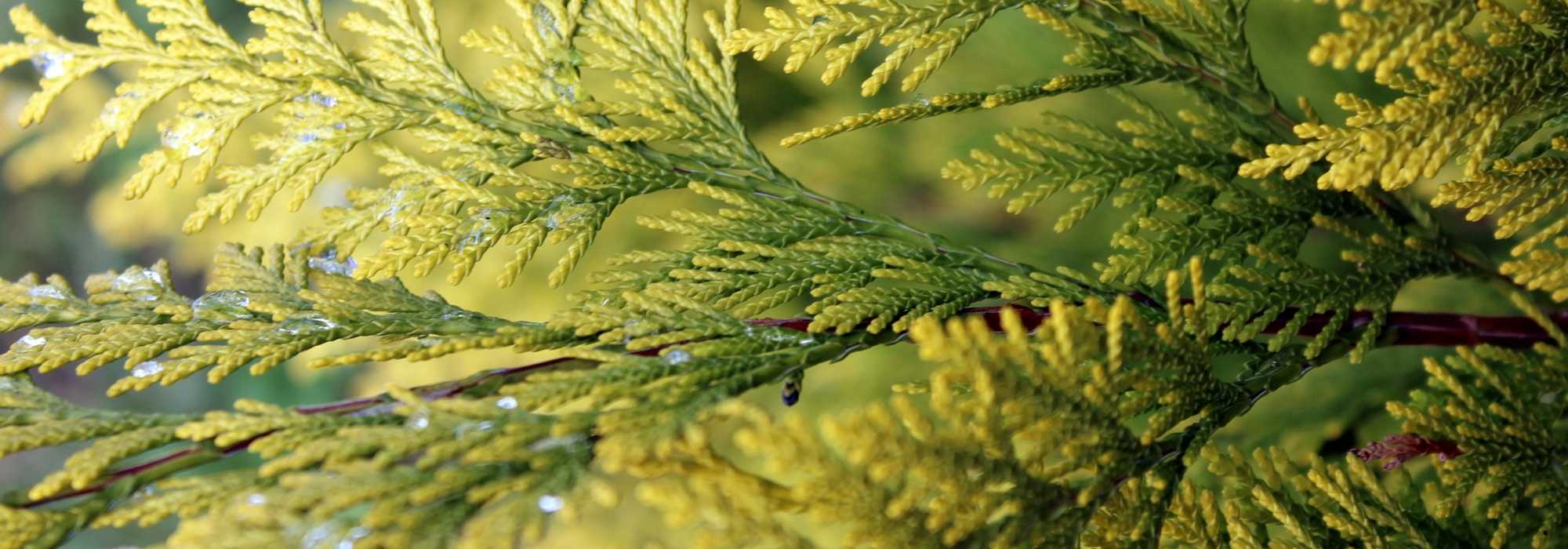
Thuja: planting, pruning and care
Contents
Thuja, in a nutshell
- Thuja are conifers with scaly leaves widely used to form hedges with rapid growth but which also produce very attractive solitary specimens, varied in shape, colour and habit.
- Varied selection of cultivars of low to very low vigour (0.75 to 2.50 m) makes them suitable for filling a rockery, a terrace planter, marking out a path or forming a small stand alongside other essential oil-bearing trees.
- Thuja are very easy to grow in all soils, from dry to wet, and require no maintenance or pruning when location suits dimensions of variety.
A word from our expert
Thuja is certainly the most popular conifer in our gardens despite its distant North American or Chinese origins. Its rapid growth and low requirements have made it an ideal candidate for creating dense hedges, easy to prune, though with some drawbacks. Hedge of Thuya plicata ‘Atrovirens’ has become so common in housing estates that diseases sometimes spread through them rapidly. Their vigour in fresh soil sometimes requires two to three prunings per year to keep a hedge to 2 m in height.
With ongoing loss of biodiversity, current trend is rather to vary hedge species and to use leafy evergreen and deciduous bushes that are melliferous or produce berries for wildlife. Thuja nevertheless offer other qualities not to be overlooked. First, Thuya plicata deserves to be restored to its former glory — also called giant Thuja or Western redcedar — capable of reaching heights of 60 m in its native habitat (30 m in Europe) and of layering until forming a spectacular grove 60 m in circumference, as at Arboretum des Barres in Loiret. It is an important forest species of the north-west United States. Its cousin from eastern United States, Thuja occidentalis (Canadian Thuja or white cedar), with glossier bright green foliage, offers a more compact conical habit not exceeding 15 m in height and is used both as a specimen and to form hedges, clipped or untrimmed. Chinese thuja (Platycladus orientalis), bearing cones with recurved tips, is also prized in small gardens and for growing in pots. Numerous dwarf cultivars exist among these three species with very different habits — globose, columnar, weeping — and varied hues ranging from golden in Thuya d’Orient Aurea Nana or Thuja occidentalis Rheingold to dark green, through coppery tones in Thuja occidentalis Golden Tuffet, or bluish-green in Thuja occidentalis Mr. Bowling Ball , with twisted shoots in Thuja occidentalis Zmatlik, and variegated yellow shoots in Thuya plicata Zebrina…
Description and botany
Botanical data
- Latin name Thuja
- Family Cupressaceae
- Common name Giant Thuja, Chinese Thuja, Canadian Thuja
- Flowering March to April
- Height between 0.75 and 30 m
- Sun exposure sun or partial shade
- Soil type any loose, well-drained soil, even calcareous
- Hardiness Excellent (-20 to -34°C)
Thujas, whose Latinised scientific name is Thuja, are conifers with scale-like shoots similar to the cypresses (Cupressus), false cypresses (Chamaecyparis) and certain junipers (Juniperus). They belong to family Cupressaceae. Flattened shoots distinguish them from Cupressus, as do their smaller, non-spherical cones (12 to 18 mm) that resemble the shape of a tulip. Their leading shoot remains straight whereas that of Chamaecyparis curves. The genus comprises five species if Thuja orientalis — now named Platycladus orientalis, the only species of that genus — is excluded. However, for simplicity this fact sheet treats Thujas in a broad sense. The Japanese thuja (Thujopsis dolobrata) is a conifer related to Thuja, recognisable by white patches on the underside of its scales.
Thujas originate from cool temperate, often well-watered regions of North America and north-eastern Asia (China and Korea). When the giant thuja grows on wet alluvial soils, rich dry soils or sphagnum bogs of western North America, Canadian thuja occupies eastern bogs as well as marshy areas with underlying calcareous rock or very shallow calcareous soils, notably in the Appalachians. These conifers generally grow in mixture with other forest species such as Douglas fir, Sitka spruce, Tsuga heterophylla, poplars, alders, birches, ashes…

Thuja occidentalis – botanical illustration
Giant thuja (Thuja plicata) readily reaches 40 to 60 m in its native range, from southern Alaska to northern California, at altitudes from 0 to 2,000 m, which explains the rapid growth of Thuja hedges even when cultivars are less vigorous, such as ‘Atrovirens’ capable of reaching 20 m. It can live up to 800 years. Species occidentalis (Canadian) and orientalis (Oriental) are much less vigorous, forming pyramidal trees of 15 to 18 m, often conical and compact in isolated or cultivated specimens. The trunk of Thuja occidentalis generally reaches 15 m in height for 30 cm in diameter with an almost columnar habit, but specimens with trunks 25 m high and 90 cm wide are found, as well as small stunted trees over 700 years old growing on the calcareous cliffs of Niagara or in northern Ontario. Platycladus of the Orient, nicknamed “tree of life” by Chinese Buddhists, retains branches down to the ground and a conical to columnar habit for a long time before developing a short trunk and a rounded crown of ascending slender shoots.
Thuja leaves are scales 1 to 3 mm long that persist for several years. These squamiform leaves are imbricate and arranged in four ranks along the flattened shoot, lateral leaves being folded in two. On erect, cylindrical shoots the scales are more elongated, measuring up to 10 mm long. Branchlets divide laterally like a fan, producing a set of flat shoots that brown and fall after several years. Canadian thuja (occidentalis) bears resiniferous glands on the back of the scales, clearly visible unlike those of the giant thuja. Oriental thuja displays branchlets grouped on vertical planes, giving a characteristically vertically striate appearance.
Trunk bark, smooth and thin, becomes channelled and splits into long thin strips with age. Roots are superficial, very long and sparsely ramified, with long thin reddish-purple rootlets.
Male and female flowers appear on the same tree in April or May. Male cones, reddish, ovoid to globular and about 4 mm, form at shoot tips, generally on branches different from the female flowers. Female conelets, green or purplish, also measure about 4 mm before developing into elongated cones of 10 mm. These, composed of 4 to 8 leathery scales, open in autumn to disperse small winged seeds over winter. In oriental thuja, cones are fleshy and bear scales bristly with a recurved point that change from a waxy-blue hue to brown. Its seeds have no wing.
Thuja wood is soft, light, aromatic but devoid of resin ducts and resistant to rot. It splits easily and is used for making shingles, posts, doors, boats, even totem poles and canoes in Native American culture. Wood of Chinese thuja is burned as incense or used in temple construction.
Main Thuja varieties
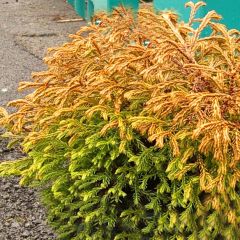
Thuja occidentalis Golden Tuffet - Canadian Arborvitae
- Height at maturity 70 cm

Thuja occidentalis Danica - Canadian Arborvitae
- Height at maturity 1 m
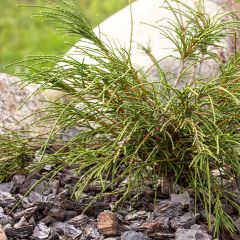
Thuja plicata Whipcord - Western Red Cedar
- Height at maturity 1 m
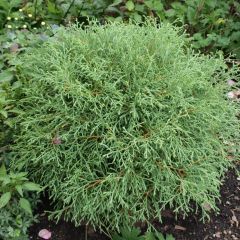
Thuja occidentalis Mr Bowling Ball - Canadian Arborvitae
- Height at maturity 1 m
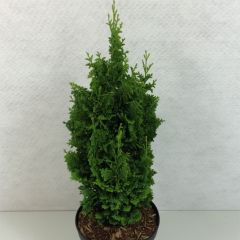
Thuja occidentalis Zmatlik - Canadian Arborvitae
- Height at maturity 2,50 m
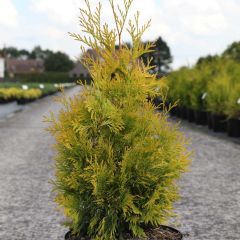
Thuja occidentalis Yellow Ribbon - Canadian Arborvitae
- Height at maturity 3 m
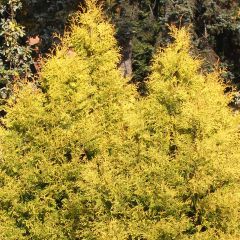
Thuja occidentalis Rheingold - Canadian Arborvitae
- Height at maturity 1,50 m
Discover other Thuya - Thuja
View all →Available in 4 sizes
Available in 2 sizes
Available in 3 sizes
Available in 3 sizes
Available in 1 sizes
Available in 3 sizes
Available in 2 sizes
Available in 1 sizes
Available in 2 sizes
Planting Thuja
Where to plant Thuja?
These very hardy, undemanding conifers are suited to all our regions. Giant and Canadian Thuja tolerate down to −34°C and −28°C respectively, while Oriental Thuja tolerates only down to −20°C. The latter prefers the damp conditions of an oceanic climate, sheltered from strong winds, whereas plicata and occidentalis as well as dwarf Thuja cultivars, although they appreciate a cool soil, tolerate dry situations well where their growth is reduced. Excess moisture can lead to serious diseases such as Phytophthora when they form hedges. Ensure you plant them in drained soil.
Exposure can be sunny to semi-shaded.
When to plant?
Prefer autumn (October–November) to plant Thuja, or February–March.
How to plant?
This plant is easy to grow. To create a trimmed Thuja hedge, space plants 80–100 cm apart and up to 2 m if it is a windbreak left in free habit.
- Plunge the pot into a bucket of water to soak it thoroughly.
- Dig a wide hole at least three times the width of the rootball because the roots remain fairly shallow and spread widely.
- Avoid planting a thuja near a bed of perennials or annuals or near a vegetable plot unless they are dwarf varieties.
- Add a few handfuls of sand and gravel to ensure good drainage around the roots. In heavy soil, opt for planting on a raised mound or within a rockery.
- Add a dose of horn meal if the soil is sandy.
- Place the plant in the planting hole.
- Replace the soil and firm lightly.
- Water.
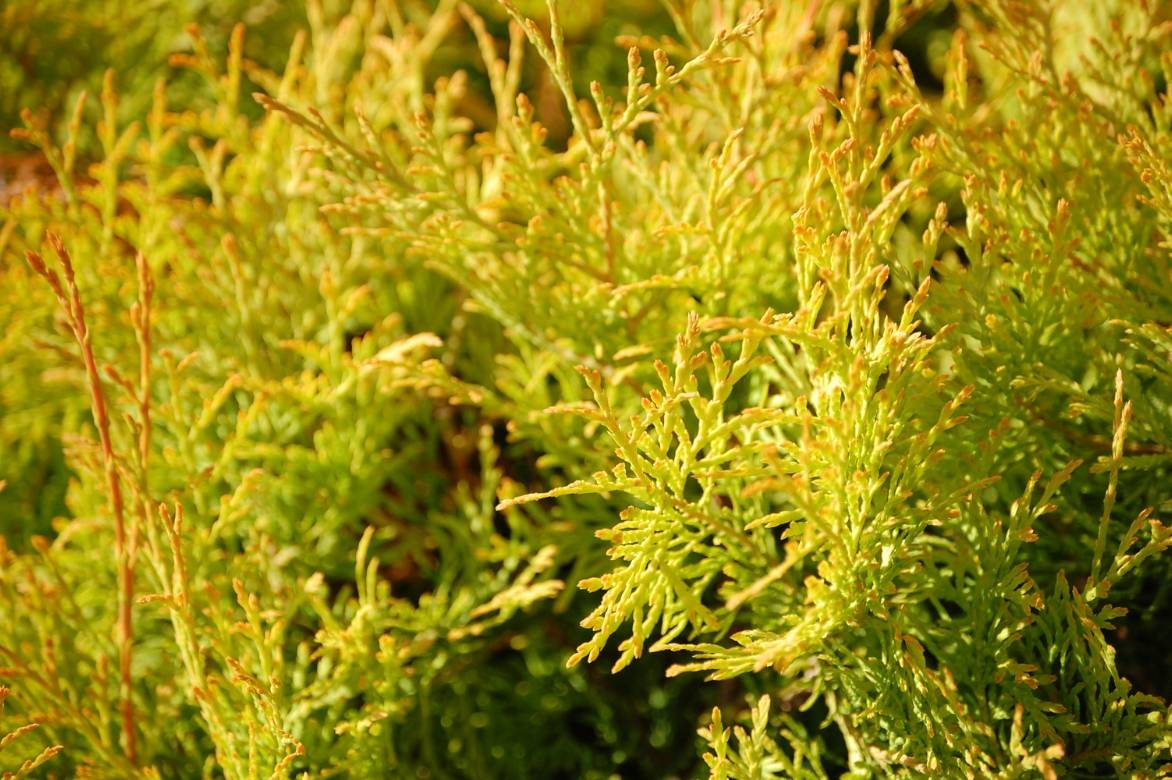
Some Thuja have particularly bright foliage such as T. occidentalis ‘Rheingold’, ‘Golden Tuffet’, ‘Golden Globe’, etc
Read also
Diseases and parasitic pests of thujaCare and pruning
Main pests and diseases of Thuja
Thuja planted alone and away from thuja hedges generally requires no maintenance. However, its very common use in single-species hedges sometimes leads to rapid contagion such as more or less severe twig dieback, which can be caused by:
- colonies of aphids (apply an insecticidal treatment quickly such as soap or fern manure),
- juniper buprestid which tunnels into the wood and causes browning in summer. The only solution is to cut and burn the swollen branches.
- diseases such as cryptogamic browning. This appears on lower branches during wet springs. Apply a fungicidal treatment every 15 days based on copper or a decoction of horsetail, or cut and burn affected branches. Phytophthora, which causes progressive drying out of the entire tree, shows necrosis under the bark of the collar tissues and roots. Uproot and burn affected specimens and plant non-susceptible plants (Chamaecyparis is the conifer most susceptible to this decline).
Pruning Thuja
Carry out pruning on trimmed hedges 1 to 2 times per year in April and August with a hedge trimmer or a shear. Always leave foliage because old wood does not produce shoots. Dwarf forms or those with a particular silhouette planted alone are merely adjusted if necessary by light pruning. You can also create a hedge with conical Thuja specimens from Canada or the Orient without carrying out pruning.
Propagation
The simplest way to multiply plants is to take twigs as cuttings in August–September.
Propagation by cuttings
Prepare a box by filling it with a mix made up of equal parts turf and sand.
- Take 10 cm-long twigs by pulling them to retain a strip of bark.
- Remove branching near the base of the twig.
- Insert these to one-third of their length, taking care they do not touch.
- Firm down gently all around to remove air pockets and ensure good contact between compost and cutting.
- Place them under a cold frame until spring.
- Pot up or plant out cuttings in a nursery for 1–2 years, or plant directly in final position if soil is favourable.→ Discover our tutorial : How to take cuttings from conifers?
Uses and companion plants
Foliage of thuja offers varied textures and shades that sometimes declinate to other colours over seasons such as in Thuja plicata Atrovirens which changes from dark green to reddish with cold, Thuja occidentalis Golden Tuffet with tousled yellow shoots in summer that turn orange in winter, Platycladus orientalis Elegantissima that shifts to bright yellow… Use these qualities to brighten or energise a neglected corner of garden.

Idea for a planting scheme for a border: 3 to 5 Thuya occidentalis ‘Smaragd’ surrounded by Crocosmia ‘Lucifer’, Dahlia ‘Karma Choc’, a few clumps of Pennisetum orientale, Sedum ‘Purple Emperor’ and Festuca glauca in foreground. Do not hesitate to add dogwoods with coloured wood in background to enliven winters !
Graphic forms — spherical, weeping, pyramidal — sit well with large stones, geometric lines of pools or buildings. But add a touch of madness by mixing them with tousled forms of grasses such as Miscanthus or Pennisetum, or conversely with a series of other dwarf conifers with prostrate habit (Juniperus horizontalis Blue Chip), globose (Picea abies Little Gem), or with indestructible Microbiota decussata whose autumn colour turns to bronze. The real graphic qualities of conifers assert themselves naturally in contemporary garden design, which prefers aesthetics of shapes, silhouettes and textures to parade of flowering. These plants with reassuring permanence structure a border sustainably, mark paths, edge terrace, easily substituting for strong presence of clipped boxwood or holly. The key is to play with volumes and colours.
With a habit naturally conical and narrow as in Thuya occidentalis Barbant or Thuya occidentalis Yellow Ribbon, you can create an original hedge without pruning work that will become contiguous over time with planting distance of 1 m. Conversely, spacing of 70 cm and repeated pruning will very quickly produce an opaque, uniform screen.
To learn more
Discover:
- Subscribe!
- Contents
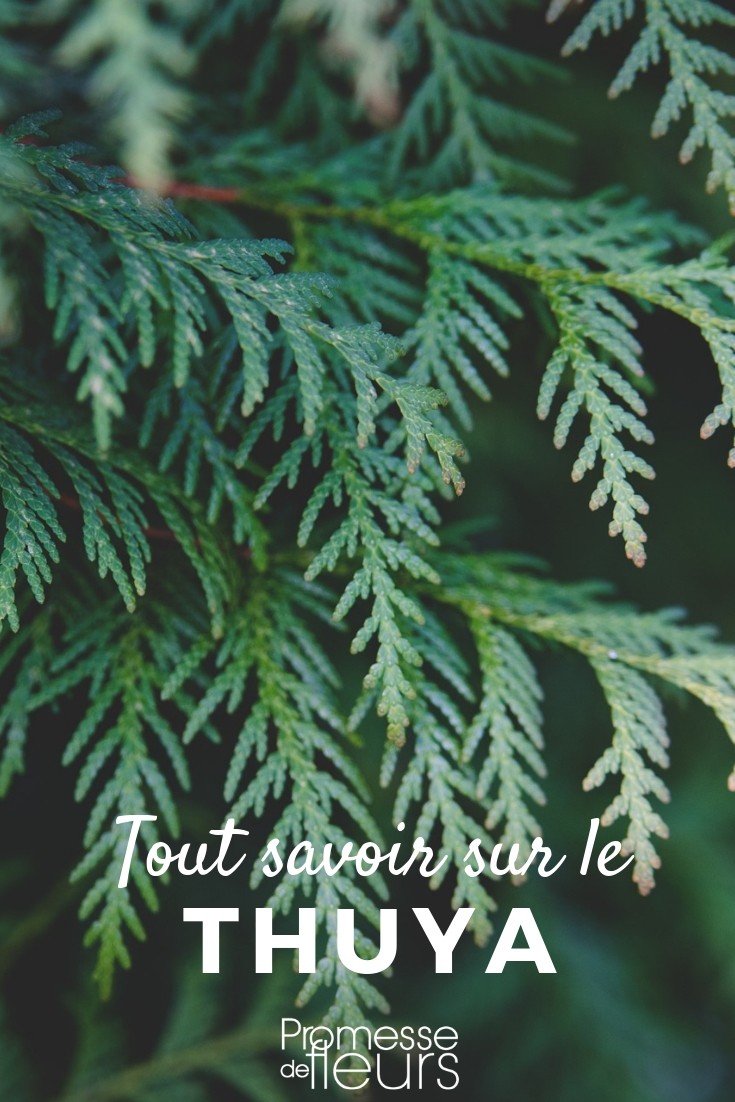
































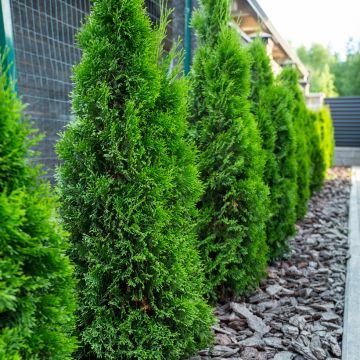
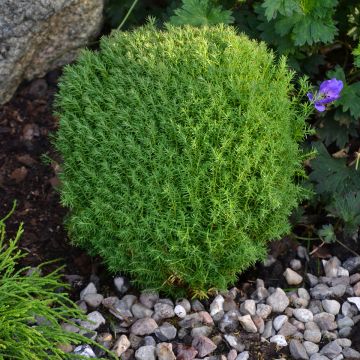

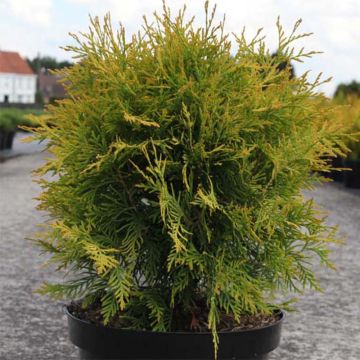

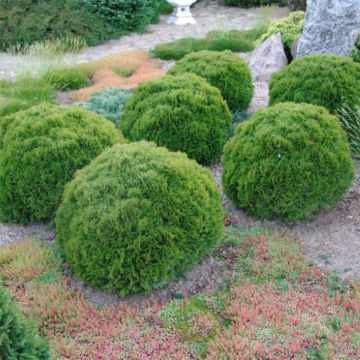
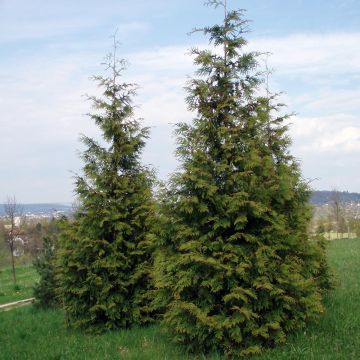
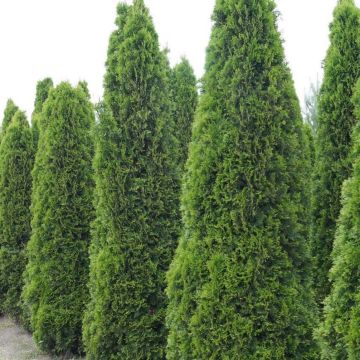

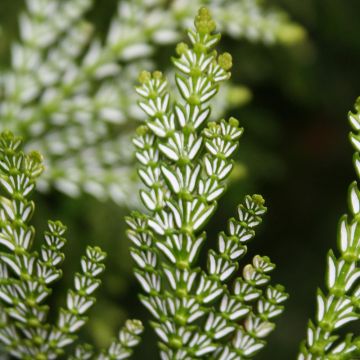
Comments